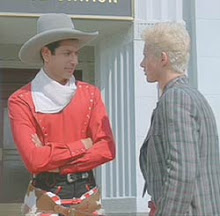Produced by Adrian Barber; written by Steven Tyler
Columbia 45894 1973 Billboard: # 59
Columbia 10278 1976 Billboard: # 6

I'm always surprised when I find the occasional old reference to Aerosmith as a "heavy metal" band. In what way were they heavy? Okay, like Led Zeppelin, Black Sabbath, and a number of other rock bands that started in the early 70s, they prominently featured loud guitars and were explicitly based in the electric blues--but so were the Stooges, and I wouldn't call them metal either. Loud guitars and being based in the blues pretty much covers everything in rock except folk-rock. I also refuse to use the term "classic rock" (except as a last-ditch label for this posting, of course) since it is a bit of a cop-out. "70s rock" would probably be more honest.
Actually, the best term might be "arena rock." I know Aerosmith has played gigs in small clubs, but it's honestly hard to imagine it. This kind of rock and roll is about large gestures and epic moments, the kind of bathetic onstage display that could play to tens of thousands of people even before you could count on the jumbotron to show you the band's specific facial expressions and subtle body movements. Aerosmith probably moved more product in the late 80s and early 90s, but their aesthetic seems firmly rooted in the 70s. That was the moment when rock went Large, the moment that so many punks felt the desperate need to ironize.
And nothing demonstrates the Largeness (as opposed to the Heaviness) of this particular moment in rock history than the tradition of the Power Ballad. While Zeppelin's Plant and Page may have grown to despise "Stairway to Heaven," Steve Tyler and Joe Perry still love playing "Dream On." The single has charted twice and been significantly rerecorded by Aerosmith once (in an influential orchestral arrangement by the late Michael Kamen). Each time, the song seems to get . . . well, bigger. This was Aerosmith's first single to crack the Hot 100, but it charted again three years later, peaking much higher. Even more signficant, the later, higher-charting version is longer: in 1973, single lasts 3 minutes and 25 seconds; in 1976, it lasts 4 minutes and 28 seconds.

On first hearing, "Dream On" may not sound like that remarkable a song. Not only are the lyrics generic enough to almost qualify as phylogeneric, but Perry's guitar work here isn't nearly as flashy as it usually is. This is a song best listened to at 3am while you're still in high school, even if (like Bruce Springsteen's "Thunder Road," written the following year) this is a young man's song about growing old. It's a quiet, solitary, even pensive song, and yet it seems made for a mass singalong, probably two numbers before the bows and encores.
In musical theatre, they'd call this an "11th hour number," and that's actually my point in this posting: in its heyday. arena rock was musical theatre. It didn't play like jazz or punk, finding a vibe and seeing where it leads. Arena rock purposefully used--and at its best, still uses--a variety of musical tempi and colors to take its listeners on a two-hour emotional journey. "Heaviness" was only one of those colors. Sentiment such as we find in this song was another.
Some have compared such concerts to religious services, but I think it's more accurate to view them in terms of the Poetics of tragedy that Aristotle evolved a century after the fact to explain why he thought Sophocles' plays worked and Euripides' didn't. As with the original audiences attending Sophocles' plays, the Aerosmith fan knows the story already, he knows where it comes and where it goes, but he needs to wallow in it. For a fan, such concerts help the listener achieve what Aristotle called catharsis, which can be translated from the Greek as either the "purification" or the "purging" of unwanted emotions.
As Aristotle would probably agree if pressed, such things should be done in moderation. Even too much Sophocles can be unhealthy for the soul. Sometimes, though, you just need the occasional plate of carb-loaded comfort food, and then you can go back to eating healthy.


No comments:
Post a Comment